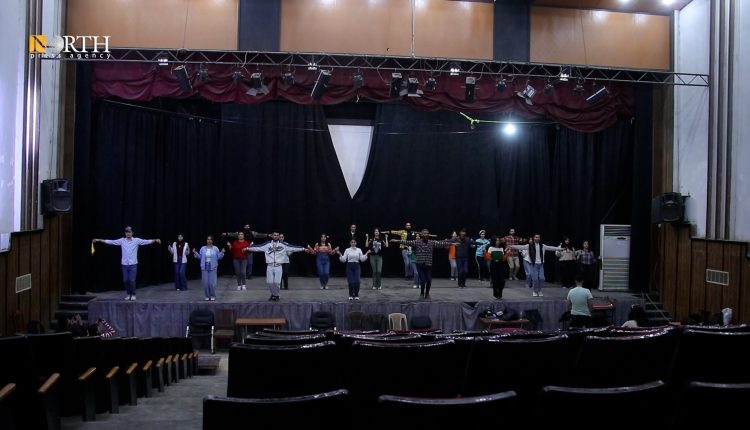
By Nalin Ali
QAMISHLI, Syria (North Press) – As the Kurdish New Year, Newroz, approaches on March 21, markets in Qamishli bustle with activity as Kurds shop for traditional fabrics and prepare for the festivities. Demand for vibrant Kurdish attire remains high, a deep-rooted cultural heritage that continues to thrive.
Armanj roams the markets of Qamishli, in northeastern Syria, searching for fabric to tailor a traditional Kurdish outfit in preparation for Newroz, the Kurdish New Year, which is celebrated on March 21 each year.
With the arrival of spring, residents of Qamishli and other Kurdish-majority areas in Syria begin preparations for Newroz, leading to a surge in market activity as people gear up for the celebrations.
“A Sacred holiday”
“Newroz is a national and sacred holiday for us,” says Armanj Mohammed, a resident of Qamishli. Every member of the family prepares for this day by getting their traditional Kurdish attire ready.
Newroz, which means “New Day” in Kurdish, is a historic and national holiday for the Kurdish people, tracing back to their Median ancestors, who declared their freedom from oppression over 2,600 years ago.
During the rule of the Assad regime (both father and son), Kurds were banned from celebrating Newroz, and thousands were arrested for participating in the festivities. The Syrian government even resorted to shooting and killing celebrants in Raqqa, Qamishli, and other areas.
On Newroz in 2008, Syrian security forces opened fire on celebrants in several cities, particularly in Qamishli. In 2009, two people were killed in Raqqa by live gunfire, and dozens were arrested in Aleppo and other regions.
Following the downfall of the Assad regime, Syrian Kurds aspire to officially recognize Newroz as a national holiday that symbolizes liberation from oppression and secures their rights in a new national constitution.
This year, Newroz celebrations are set to take place in Suwayda, Damascus, and other parts of Syria.
Preparations start early February, tailoring dresses for both International Women’s Day on March 8 and for Newroz, Mohammed explains, highlighting the “significant demand” this year for fabrics used in traditional Kurdish attire.
Kurdish women tend to favor vibrant, colorful fabrics that reflect the essence of spring, known for its bright and cheerful hues, according to fabric vendors in Qamishli’s markets.
Khaled Amin, a fabric seller in Qamishli’s market, told North Press, that women’s fabrics are in higher demand. Women usually start preparing two months ahead by purchasing fabrics and other items for the celebration, he adds.
However, due to Newroz coinciding with Ramadan this year, Amin notes a slight drop in demand, which he attributes to the ongoing economic challenges in Syria.
“Women dressing up for Newroz reflect nature’s beauty. Newroz itself means the ‘new day.’ When women and girls come to shop for Newroz. We feel the festivity even before the day arrives. They choose colors inspired by butterflies, flowers, and roses, bringing joy not only to themselves but also to us,” Amin adds.
Kurdish folk costume
Rizgar Hasso, a tailor specializing in women’s traditional clothing in Qamishli, observes an increasing trend of people choosing to wear Kurdish attire not just for Newroz but also for personal celebrations.
People are showing more interest in having Kurdish attire tailored this year compared to previous years, he says. “Every year, our workload increases around this time.”
Preparations usually peak after mid-February, about a month before the celebration. Kurdish expatriates from Europe and Kurdistan Region of Iraq also place tailoring orders upon returning to celebrate Newroz at home.
The cost of tailoring a traditional Kurdish dress starts at a minimum of $30, depending on fabric quality and design. Hasso notes that tailoring prices are slightly lower this year due to the decline in the exchange rate of the US dollar.
Wearing traditional Kurdish attire remains one of the most cherished customs of Newroz.
Newroz festivities
On Newroz, people gather in open fields or designated public squares, where musical and dance performances take place. Folkloric dance groups and musicians prepare months in advance, practicing traditional Kurdish dances and patriotic songs for the celebration. The festivities also include theatrical performances that reflect the social and political realities of the region.
Najbir Ghanem, a member of a folkloric dance group in Qamishli, told North Press, that they begin preparing for Newroz in February, training three days a week on various traditional dances to be performed in Qamishli on Newroz.
She mentions that preparations this year have been particularly challenging due to Ramadan, requiring them to adjust their training schedule between morning and evening sessions to ensure a high-quality performance for the audience.
Newroz celebrations officially begin on the evening of March 20, when Kurds light the Newroz fire—a ritual dating back to the time of the Medes.
According to legend, Kawa the Blacksmith climbed a mountain holding a flaming torch, signaling victory over tyranny. Today, lighting the Newroz fire continues to symbolize freedom.
